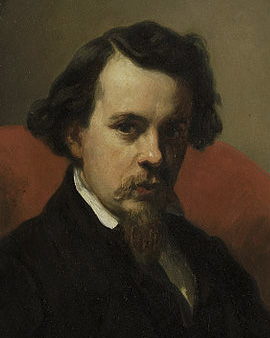Charles Henri Joseph Leickert was a painter of the romantic era. Born in Belgium, Leickert oriented himself towards Dutch artists from the very beginning of his education. Charles took private lessons in The Hague and found an artistic home in the south of the Netherlands. The creators of art and culture had postulated the age of Romanticism, thus breaking up the unity of art in Europe. Romanticism pervaded the western states of Europe and produced individual elaborations of the new feeling. The idea of Romanticism moved away from the painting of pure seeing to the personal feelings of the painter. Together with the newly awakened interest in landscapes, new views of the environment opened up. From the individual feeling of beauty, landscape views emerged that were closely connected with the artist. Romanticism developed more restrainedly in the Netherlands. No paintings with great emotional epic were created, but atmospheric and sensitively captured nature scenarios.
Charles Leickert loved the atmospheric winter scenery. Characteristic for his work are frozen lakes and skaters. Always present are the wonderful plays of light in the sky. The painter liked to capture the evening twilight and the morning hours with the winterly light. Not infrequently the play of light and clouds takes up a large part of the canvas and shows the whole spectrum of the colour palette. Leickert worked nuances from the rest of the evening's light that speak for a great love of these silent hours. The landscapes seem animated by the moving figures and the viewer feels the cold and frost of the scenery. In the painting "Sunset at the Dutch canal with windmill" the painter uses the indirect light of the sun, which is hidden behind a mill. Here Leickert succeeds in bringing out the differentiated colour nuances with great skill.
Romanticism is a time that encourages reflection on the wonders of nature in one's own country. With his paintings Leickert takes the pulse of the bourgeoisie in the Netherlands. The landscapes seem idealised and the traces of industry are neglected. The works reflect a feeling of harmony and a nostalgic notion of the untouched nature of times gone by. Charles Leickert changed his centre of life to the Dutch heart of art and moved to Amsterdam. Here he was elected a member of the Royal Academy of Amsterdam. An award that made it easier for him to sell his paintings and allowed him to teach himself. Leickert began travelling through Europe in later years. Romanticism reached its peak in the European hinterland. Especially in Germany, art was characterized by longing and sentimentality. The leading Romantic was Caspar David Friedrich, who designed his landscapes with a lot of personal expression and thus showed the individuality of the epoch.
×





.jpg)
.jpg)
.jpg)
.jpg)
.jpg)
.jpg)
.jpg)
.jpg)
.jpg)
.jpg)
.jpg)
.jpg)
.jpg)
.jpg)
.jpg)
.jpg)
_-_(MeisterDrucke-1118173).jpg)
_-_(MeisterDrucke-1118173).jpg)
.jpg)
.jpg)
.jpg)
.jpg)
.jpg)
.jpg)
.jpg)
.jpg)
.jpg)
.jpg)
.jpg)
.jpg)
.jpg)
.jpg)
.jpg)
.jpg)
.jpg)
.jpg)
.jpg)
.jpg)
.jpg)
.jpg)
.jpg)
.jpg)
.jpg)
.jpg)






